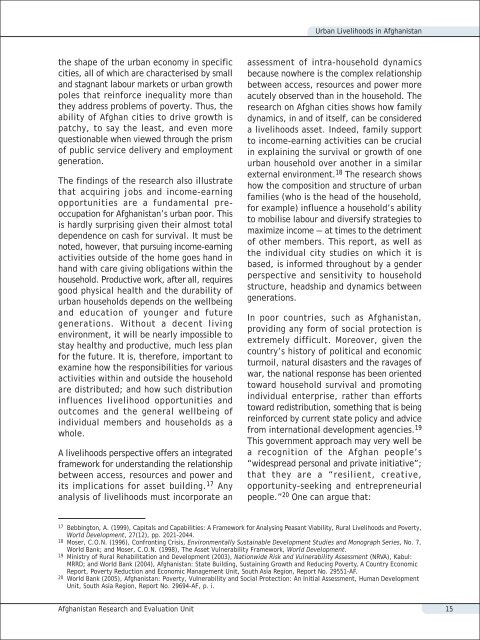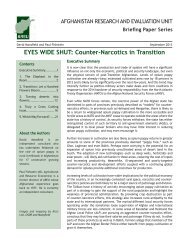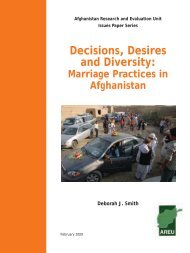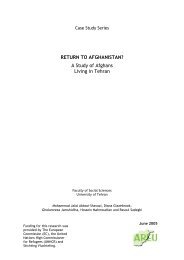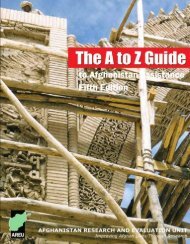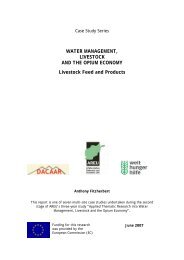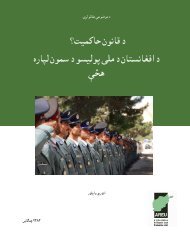Urban Livelihoods in Afghanistan - the Afghanistan Research and ...
Urban Livelihoods in Afghanistan - the Afghanistan Research and ...
Urban Livelihoods in Afghanistan - the Afghanistan Research and ...
You also want an ePaper? Increase the reach of your titles
YUMPU automatically turns print PDFs into web optimized ePapers that Google loves.
<strong>Urban</strong> <strong>Livelihoods</strong> <strong>in</strong> <strong>Afghanistan</strong><strong>the</strong> shape of <strong>the</strong> urban economy <strong>in</strong> specificcities, all of which are characterised by small<strong>and</strong> stagnant labour markets or urban growthpoles that re<strong>in</strong>force <strong>in</strong>equality more than<strong>the</strong>y address problems of poverty. Thus, <strong>the</strong>ability of Afghan cities to drive growth ispatchy, to say <strong>the</strong> least, <strong>and</strong> even morequestionable when viewed through <strong>the</strong> prismof public service delivery <strong>and</strong> employmentgeneration.The f<strong>in</strong>d<strong>in</strong>gs of <strong>the</strong> research also illustratethat acquir<strong>in</strong>g jobs <strong>and</strong> <strong>in</strong>come-earn<strong>in</strong>gopportunities are a fundamental preoccupationfor <strong>Afghanistan</strong>’s urban poor. Thisis hardly surpris<strong>in</strong>g given <strong>the</strong>ir almost totaldependence on cash for survival. It must benoted, however, that pursu<strong>in</strong>g <strong>in</strong>come-earn<strong>in</strong>gactivities outside of <strong>the</strong> home goes h<strong>and</strong> <strong>in</strong>h<strong>and</strong> with care giv<strong>in</strong>g obligations with<strong>in</strong> <strong>the</strong>household. Productive work, after all, requiresgood physical health <strong>and</strong> <strong>the</strong> durability ofurban households depends on <strong>the</strong> wellbe<strong>in</strong>g<strong>and</strong> education of younger <strong>and</strong> futuregenerations. Without a decent liv<strong>in</strong>genvironment, it will be nearly impossible tostay healthy <strong>and</strong> productive, much less planfor <strong>the</strong> future. It is, <strong>the</strong>refore, important toexam<strong>in</strong>e how <strong>the</strong> responsibilities for variousactivities with<strong>in</strong> <strong>and</strong> outside <strong>the</strong> householdare distributed; <strong>and</strong> how such distribution<strong>in</strong>fluences livelihood opportunities <strong>and</strong>outcomes <strong>and</strong> <strong>the</strong> general wellbe<strong>in</strong>g of<strong>in</strong>dividual members <strong>and</strong> households as awhole.A livelihoods perspective offers an <strong>in</strong>tegratedframework for underst<strong>and</strong><strong>in</strong>g <strong>the</strong> relationshipbetween access, resources <strong>and</strong> power <strong>and</strong>its implications for asset build<strong>in</strong>g. 17 Anyanalysis of livelihoods must <strong>in</strong>corporate anassessment of <strong>in</strong>tra-household dynamicsbecause nowhere is <strong>the</strong> complex relationshipbetween access, resources <strong>and</strong> power moreacutely observed than <strong>in</strong> <strong>the</strong> household. Theresearch on Afghan cities shows how familydynamics, <strong>in</strong> <strong>and</strong> of itself, can be considereda livelihoods asset. Indeed, family supportto <strong>in</strong>come-earn<strong>in</strong>g activities can be crucial<strong>in</strong> expla<strong>in</strong><strong>in</strong>g <strong>the</strong> survival or growth of oneurban household over ano<strong>the</strong>r <strong>in</strong> a similarexternal environment. 18 The research showshow <strong>the</strong> composition <strong>and</strong> structure of urbanfamilies (who is <strong>the</strong> head of <strong>the</strong> household,for example) <strong>in</strong>fluence a household’s abilityto mobilise labour <strong>and</strong> diversify strategies tomaximize <strong>in</strong>come — at times to <strong>the</strong> detrimentof o<strong>the</strong>r members. This report, as well as<strong>the</strong> <strong>in</strong>dividual city studies on which it isbased, is <strong>in</strong>formed throughout by a genderperspective <strong>and</strong> sensitivity to householdstructure, headship <strong>and</strong> dynamics betweengenerations.In poor countries, such as <strong>Afghanistan</strong>,provid<strong>in</strong>g any form of social protection isextremely difficult. Moreover, given <strong>the</strong>country’s history of political <strong>and</strong> economicturmoil, natural disasters <strong>and</strong> <strong>the</strong> ravages ofwar, <strong>the</strong> national response has been orientedtoward household survival <strong>and</strong> promot<strong>in</strong>g<strong>in</strong>dividual enterprise, ra<strong>the</strong>r than effortstoward redistribution, someth<strong>in</strong>g that is be<strong>in</strong>gre<strong>in</strong>forced by current state policy <strong>and</strong> advicefrom <strong>in</strong>ternational development agencies. 19This government approach may very well bea recognition of <strong>the</strong> Afghan people’s“widespread personal <strong>and</strong> private <strong>in</strong>itiative”;that <strong>the</strong>y are a “resilient, creative,opportunity-seek<strong>in</strong>g <strong>and</strong> entrepreneurialpeople.” 20 One can argue that:17 Bebb<strong>in</strong>gton, A. (1999), Capitals <strong>and</strong> Capabilities: A Framework for Analys<strong>in</strong>g Peasant Viability, Rural <strong>Livelihoods</strong> <strong>and</strong> Poverty,World Development, 27(12), pp. 2021-2044.18 Moser, C.O.N. (1996), Confront<strong>in</strong>g Crisis, Environmentally Susta<strong>in</strong>able Development Studies <strong>and</strong> Monograph Series, No. 7,World Bank; <strong>and</strong> Moser, C.O.N. (1998), The Asset Vulnerability Framework, World Development.19 M<strong>in</strong>istry of Rural Rehabilitation <strong>and</strong> Development (2003), Nationwide Risk <strong>and</strong> Vulnerability Assessment (NRVA), Kabul:MRRD; <strong>and</strong> World Bank (2004), <strong>Afghanistan</strong>: State Build<strong>in</strong>g, Susta<strong>in</strong><strong>in</strong>g Growth <strong>and</strong> Reduc<strong>in</strong>g Poverty, A Country EconomicReport, Poverty Reduction <strong>and</strong> Economic Management Unit, South Asia Region, Report No. 29551-AF.20 World Bank (2005), <strong>Afghanistan</strong>: Poverty, Vulnerability <strong>and</strong> Social Protection: An Initial Assessment, Human DevelopmentUnit, South Asia Region, Report No. 29694-AF, p. i.<strong>Afghanistan</strong> <strong>Research</strong> <strong>and</strong> Evaluation Unit 15


